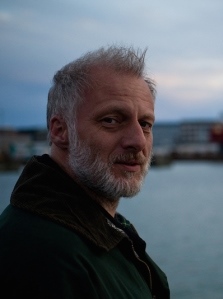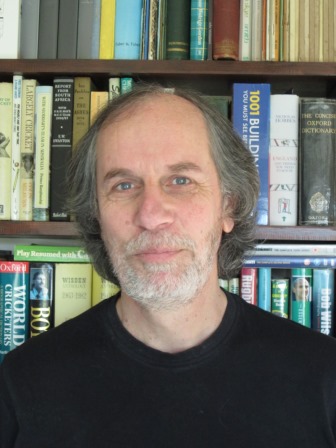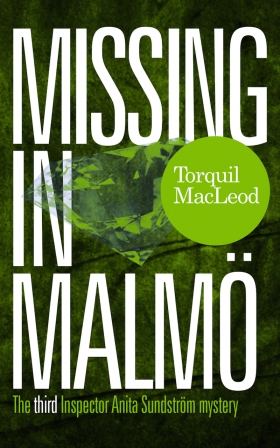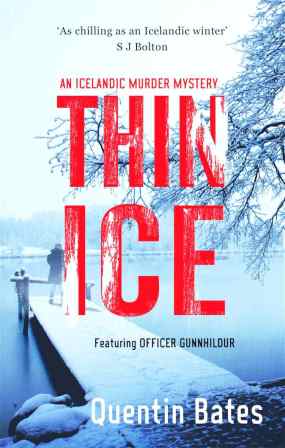Torquil
MacLeod and Quentin Bates are British crime writers who both set their fiction
in cold countries. Torquil writes a series of crime novels featuring Swedish
detective Anita Sundström set in the Skåne region of southern Sweden, while
Quentin’s books are set in Iceland – also with a female detective, Gunnhildur Gísladóttir.
We decided to bring Torquil and Quentin together to discuss writing crime, why
they’re drawn to cold climates and female protagonists, and what they’re
working on next.


Quentin: Torquil, what took you to Sweden to start with and why set a novel
there?
Torquil: I went to Sweden for the first time just
before Christmas in 2000 to visit my elder son who had moved there to be with a
Swedish girl. I was really taken with
the countryside and atmosphere in Skåne (the southernmost part of Sweden),
where we stayed. As our hostess happened
to be a blonde detective, my thoughts turned to crime. At the time, I had no interest in writing a
book, nor was I aware that Sweden was a hotbed of crime writing. Britain had
yet to discover Henning Mankell. I was attempting to break into the world of
scriptwriting at the time and I thought a Swedish story would be different. In fact, I came up with two ideas, but when
Hollywood failed to come calling (or anybody else for that matter) I decided to
turn one of them into a book, as I already had a story. As an advertising copywriter you learn never
to waste the chance to recycle an idea! And by the time I was writing the book,
my son had moved to Malmö which made a good location as I could do the
necessary geographical research on my regular visits.
Though I visit Sweden
frequently, I write from an outsider’s stance.
But you lived in Iceland for ten years.
Do you feel you write from a native’s point of view?
Quentin:
I’m not entirely sure. I lived in Iceland during the 1990s, and although I’m
able to keep in very close touch with my old home, I think I feel something of
an outsider both in Iceland and Britain. My books are set largely in and around
Reykjavík, and I spent my years in Iceland living in the north, so I bring with
me something of an ingrained amiable disdain for those soft city types down
south. This also became one of the characteristics of my detective who migrated
to Reykjavík and never went back home, which is something of a theme in
Iceland. Reykjavík really is a melting pot, the majority of people either
having come from outlying parts of the country or else their parents did, moving
to the city in search of work or education or both. Then there are the more
recent foreign immigrants as well, and it has become a very multi-cultural
place.
Having
lived there for so long and having had no choice but to learn a decent amount
of the language, I’m an insider in that I can follow the local news, keep
abreast of the intrigues and scandals that an outsider wouldn’t, and also
understand the scathing off-colour jokes Icelanderstell about their
celebrities and politicians. On the other hand, I try to write from something
of an outsider’s viewpoint, as Icelandic writers don’t go out of their way to
cover much of the local colour that people like to read about – and I guess
it’s because they’re writing primarily for a local readership and much of this
stuff is simply taken as read as it doesn’t need to be explained.
So tell me about Anita Sundström.
Where did she appear from – and did you make a conscious decision to write a
female protagonist?
Torquil:
Choosing a female lead was quite easyas I already had a role model in our
hostess (previously mentioned), who, since 2000, has become one of our closest
friends. She is still a serving detective, though not in Malmö. I hasten to add that she is only partly Anita
Sundström and that my creation is an amalgam of people. But I think I'm
naturally drawn to female protagonists because I find them more interesting,
more layered. They have more depth, have more empathy, tend to be more
perceptive and are outwardly more honest than their male equivalents, which is
probably why a lot of my failed screenplays centred round a female character.
The problem is that all my main male ones (including Jack Flyford in my historical
crime novel) end up just being version of myself (and that's not a good place
to go!). As I feel more detached from
Anita, I just think the character gives me more flexibility and allows me to
explore areas that a male detective might not stray into.
I
don't know if you feel similarly about Gunnhildur. What were her origins?
Quentin:
I have much the same feelings about Gunnhildur and writing a female character
wasn’t especially a problem, but I imagine writing a significantly younger
character convincingly would be more of a challenge than gender-hopping.
When I was working on the original draft of what became Frozen Out, the protagonist was a man. Gunnhildur was the sidekick.
After a while I realised that this chap, who was so unmemorable that I don’t
remember what name I gave him, was pretty dull. He was a collection of all the
middle-aged, grumpy detective story clichés and it dawned on me that there was
a far more interesting and engaging character there waiting to be promoted. So
he was given the boot, Gunnhildur stepped in and she seems to have done a
fairly decent job solving crimes that are way above her pay scale.
I
didn’t know any real police officers at the time, although I have since
collected a few I can go to for information. So Gunnhildur is a mixture of half
a dozen people, not all of them female, and there are facets of her that belong
to this or that person. But only I know who is the model for what she looks
like, and my lips are sealed on that.
Your books are anchored firmly
in Skåne. I’m wondering how closely she is tied to the setting? Could you take
Anita out of Skåne - and would you want to try?
Torquil:
Skåne, and particularly Malmö, is rich in criminal possibilities, and there are
plenty of stories that can be conjured up on Anita Sundström's home ground. But
as I introduced her in the first book in the series through the eyes of a
British journalist, I am quite happy for her to wander. Half the action of Missing in Malmö takes place in England,
and in Midnight in Malmö she ends up
in Berlin while one of her team goes digging for information about a case in
Switzerland. As Malmö is such a cosmopolitan city, it has a wonderful mix of
residents and visitors who have roots and connections elsewhere. And Swedes
head overseas, too. Last year over 51,000 emigrated which, though a small
number in British terms, is significant in a population of only nine million.
In fact, 90,000 Swedes live in the UK. So it's natural that occasionally an
investigation leads beyond the boundaries of Skåne. And I like having the
flexibility of taking Anita away from her normal beat because I personally
enjoy stories where characters move from one location to another. It seems to
go down well with American readers, some of whom even go onto Google Earth to
track a character's movements.
A sense of location is
important as you can tell from your descriptions of Reykjavik. But are all your locations real, or are some
made up?
Quentin:
Both! Gunnhildur lives in a fictional coastal village called Hvalvík, which I
placed on the southern coast of the Reykjanes peninsula. The original intention
was to give her a much more rural beat, but things didn’t pan out that way and
for a variety of reasons, Gunnhildur found herself solving serious crimes in
Reykjavík instead, commuting from coastal Hvalvík. The village has features
that are very real, borrowed from other places, but I didn’t want to use a real
village, however thinly disguised Hvalvík is and a few people have guessed correctly
where it is.
Reykjavík is a different matter and I tend to use real locations when I can,
bending the truth when necessary. If there’s an address needed, I’ll often use
a real street but make sure that particular number doesn’t exist, or place an
imaginary factory on a real industrial estate. I like to use locations that are
away from the centre of the city that visitors to Reykjavík see. Relatively few
visitors venture past the 101 district unless they’re going outside the city
altogether, so I like to use the suburbs; Hafnarfjördur, Kópavogur and
Mosfellsbær. I also like to use cafés and bars that exist, sometimes with the
names altered, but not always.
I
suppose many of the locations in the books reflect the side of Iceland that I
normally see, the places I’m most familiar with as harbours and industrial
estates seem to be where most of the people I know there spend their time, so
that’s where I’m normally to be found.
There’s
a huge contrast between Reykjavík, especially the 101 district, and the rest of
the country. Once you’re past the Hvalfjördur tunnel, everything slows down and
attitudes are different. So I’d like to take Gunnhildur out of the city more,
maybe back to the Westfjords fishing village where she has her origins, if I
can come up with a suitable crime that’s worthy of her attention out there in
the back of beyond. I do have the beginnings of just such a tale, so maybe it’s
time to dust that one off.
How did you come up with your
cast of supporting characters, Anita Sundström’s colleagues and family? How
important to the series has it been to develop the background characters
alongside Anita?
Torquil:
When I was writing the first book I wasn't thinking in terms of a series. But
what changed my mind was not only the way Anita was developing, but also the
team she worked within. It was the team
I wanted to take onto the next book.
Initially I created the characters to fulfil various roles - the overbearing
boss; the older mentor; the younger, aggressive cop who sees Anita as a threat. But by taking them into further books, I
could turn what, to start with, may have seemed like stereotypical characters
into more rounded individuals on the page. With each book, I've had more time
to develop them further. In fact, some
of the cases are handled by other members of the team and do not directly
involve Anita. I have to admit, I've become fond of them all; even the
despicable ones! As for Anita's family
background; I didn't want her to be the typical maverick cop. So, even though
she's a single mother, she doesn't have any particular hang-ups. Her life is fairly normal, though her son is
central to her existence. The mother-son relationship is the main one in her
life, and so tensions arise when girlfriends appear on the scene. And, of
course, there is the clever but feckless ex-husband, whom I kept up my sleeve
until Missing in Malmö. Anita
wouldn't be the character she is if she didn't have family and colleagues to
constantly interact with.
What intrigues me about you,
Quentin, is that you're not only a successful crime writer but also a
translator of Icelandic crime fiction.
When translating other people's books, do you find yourself thinking -
'I would have done that differently at that point.'?
Quentin:
I don’t have a problem with that, so far. The books I’m translating (by Ragnar
Jónasson) are pretty different from my stuff, so that doesn’t arise as much of
his work consists of situations I wouldn’t have written about to begin with.
It’s more likely that I’ll see something and wish I had thought of it myself. Translating does mean treading quite a fine
line between interpreting what the author wrote and producing a faithful
translation, as there are all kinds of things that can’t be translated
directly; idioms, jokes, swearing, etc, so alternatives have to be found. Once
the translation is done, it’s the editor’s job to go at it with a carving knife
and a red pen. But the translator should resist any temptation to improve on
the original.
Interesting that you wanted
Anita to be a fairly normal sort of character without the crime fiction cliché
hang-ups. I have to admit that when I started writing Gunnhildur, I had much
the same thoughts. There are enough grumpy, booze-sodden middle-aged male
detectives already and I didn’t want to just produce a female version of the
same. What’s next for Anita? I know
you’re working on something new, so when is it likely to be published, and are
you giving Anita any new challenges – and is there anything else on the back
burner?
Torquil:
Yes, I've started working on Menace In
Malmö and Anita is in the middle of facing fresh challenges. This will be
her sixth outing, though I don't expect the novel to appear until after
Christmas. As for other projects, I've still got the next Jack Flyford
Misadventure (my feckless 18th-century actor) on the back burner. But as the Sundström books take priority, it
might be a long time before he returns to cause chaos in the criminal world of
Georgian Britain. I have one or two other ideas bubbling away, but it's a
matter of finding the time. But that's an easily distracted writer's excuse!
It's
always exciting when a new book like Thin Ice comes out. But are you already planning your next
writing venture or have you more translation projects in the pipeline?
Quentin: I
have three more of Ragnar’s books to translate, so that’s going to take up a
lot of the next year. I’m hoping to get one more translation, but I’ll keep
quiet about that one for the moment other than to say it’s something special
and definitely deserves to be available in English. Thin
Ice is in fact a year or so later than it should have been, for various
publisher reasons that I’ll not go into. So I’ve tinkered with other things in
the meantime. There is another Gunnhildur story in the works, although I can’t
be sure yet if it’ll be a novella or a full novel. There are also a few other
ideas, including something else that’s crime but not Gunnhildur, plus a
historical thing that’s going to call for an amount of research that I don’t
have time to do – yet. That one looks like it might turn into a labour of love,
but one I’d like to be able to finish it before I get my bus pass.
Thanks
for the chat, it’s been fascinating. I’ve found out a loads of interesting
stuff and look forward to seeing Anita Sundström’s next challenge!
Torquil
MacLeod's fourth Anita Sundström mystery Missing
in Malmö comes out in paperback on March 30th through McNidder & Grace.
You can find out more about Torquil MacLeod on his website.
 When
a woman is stabbed to death while jogging in Malmö’s main park, the Criminal
Investigation Squad need to discover who she is before the case can properly
get under way. Soon they realise the victim had flown in from Switzerland, and
with links to important people in the city, she wasn’t everything she
seemed. Meanwhile, enjoying the hot summer away from Malmö, Anita Sundström
is on her annual leave and is showing Kevin Ash the sights of Skåne. Their
holiday is interrupted by the apparent suicide of a respected, retired
diplomat. After a further death, Anita finds herself unofficially investigating
a case that has its roots in the 1917 chance meeting of a Malmö waiter with the
world’s most famous revolutionary. All she knows is that the answers lie in
Berlin. Two investigations that begin and end at Missing in Malmö.
When
a woman is stabbed to death while jogging in Malmö’s main park, the Criminal
Investigation Squad need to discover who she is before the case can properly
get under way. Soon they realise the victim had flown in from Switzerland, and
with links to important people in the city, she wasn’t everything she
seemed. Meanwhile, enjoying the hot summer away from Malmö, Anita Sundström
is on her annual leave and is showing Kevin Ash the sights of Skåne. Their
holiday is interrupted by the apparent suicide of a respected, retired
diplomat. After a further death, Anita finds herself unofficially investigating
a case that has its roots in the 1917 chance meeting of a Malmö waiter with the
world’s most famous revolutionary. All she knows is that the answers lie in
Berlin. Two investigations that begin and end at Missing in Malmö.
Quentin
Bates’s fifth Gunnhildur novel Thin Ice
is published on the 3rd of March by Constable.
More information about Quentin Bates can be found on his website. He is also part of Iceland
Noir. You can also follow him on Twitter @graskeggur.
 Snowed
in with a couple of psychopaths for the winter... When two small-time crooks
rob Reykjavik's premier drugs dealer, hoping for a quick escape to the sun,
their plans start to unravel after their getaway driver fails to show. Tensions
mount between the pair and the two women they have grabbed as hostages when
they find themselves holed upcountry in an isolated hotel that has been
mothballed for the season. Back in the
capital, Gunnhildur, Eiríkur and Helgi find themselves at a dead end
investigating what appear to be the unrelated disappearance of a mother, her
daughter and their car during a day's shopping, and the death of a thief in a
house fire. Gunna and her team are faced
with a set of riddles but as more people are quizzed it begins to emerge that
all these unrelated incidents are in fact linked. And at the same time, two
increasingly desperate lowlifes have no choice but to make some big decisions
on how to get rid of their accidental hostages...
Snowed
in with a couple of psychopaths for the winter... When two small-time crooks
rob Reykjavik's premier drugs dealer, hoping for a quick escape to the sun,
their plans start to unravel after their getaway driver fails to show. Tensions
mount between the pair and the two women they have grabbed as hostages when
they find themselves holed upcountry in an isolated hotel that has been
mothballed for the season. Back in the
capital, Gunnhildur, Eiríkur and Helgi find themselves at a dead end
investigating what appear to be the unrelated disappearance of a mother, her
daughter and their car during a day's shopping, and the death of a thief in a
house fire. Gunna and her team are faced
with a set of riddles but as more people are quizzed it begins to emerge that
all these unrelated incidents are in fact linked. And at the same time, two
increasingly desperate lowlifes have no choice but to make some big decisions
on how to get rid of their accidental hostages...
cheats
site why women cheat in relationships
viagra kaufen
read viagra bei frauen
motilium et grossesse
site motilium enceinte